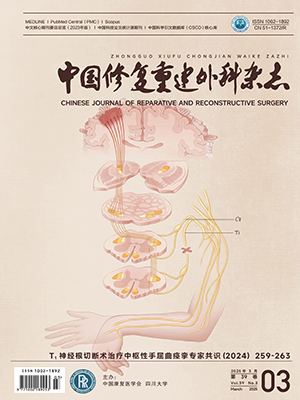Objective To observe expression of Caspase-3 and apoptosis around the prosthesis and explore the relationship of the expression and the apoptosis with the periimplant osteolysis. Methods From April 2001 to August 2006, 16 patients (10 males, 6 females) underwent the revision total hip arthroplasty surgery, who had the primary total hip arthroplasty at the ages of 45-67 years and had the revision total hip arthroplasty at the ages of 55-78 years, with the implantation duration of 7-13 years. According to their preoperative X-ray films andthe findings during the operation, the patients were divided into two groups: theloose/osteolytic group (n=8) and the loose/non-osteolytic group (n=8). The interface tissues were obtained from the peri-implant region in the patients. The synovial samples were taken from another 6 patients (2 males, 4 females; age, 54-68years; illness course, 9-15 years), who underwent the primary total hip arthroplasty for osteoarthritis. These 6 patients were used as controls. The tissues were prepared for the immunohistochemical assays to determine the expression of Caspase-3. The TUNEL assays were performed to quantify the apoptotic cells. The quantitative analysis on the positive cells and the correlation with the presence of the particulate wear debris and the severity of osteolysis were also performed. Results The level of the expression for Caspase-3 and the apoptosis index inthe loose/osteolytic group were significantly increased when compared with those in the loose/non-osteolytic group and the control group (P<0.01). The polyethylene particles were surrounded by more positive cells than the metal particles. The positive cells were present at a higher level in the tissue sections where the high-wear status was present when compared with the areas where the low-wear status was present (P<0.05). Conclusion There is a statistical correlation of the Caspase-3 expression to the apoptosis index and to the presence of the particulate wear debris and the severity of osteolysis, which may be one of the key points for the bone reconstruction inhibition and the bone resorption at the boneimplant interface under the stimulation of the wear debris. The apoptosis is involved in the pathogenesis of the aseptic loosening, which is closely related to the signal transportation of Caspase-3.
Citation: CHENG Tao,DAI Min,WEI Jinzhong,et al.. EXPRESSION OF CASPASE-3 AND APOPTOSIS IN INTERFACE MEMBRANES OF ASEPTICALLY-LOOSE TOTAL HIP REPLACEMENT. Chinese Journal of Reparative and Reconstructive Surgery, 2007, 21(8): 810-813. doi: Copy
Copyright © the editorial department of Chinese Journal of Reparative and Reconstructive Surgery of West China Medical Publisher. All rights reserved




